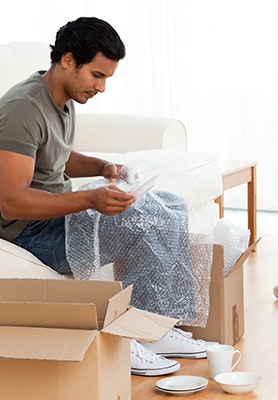 Regardless of whether you have already started to pack up your home for an upcoming move, or whether you plan to initiate that tough project in your moving calendar, you should be already well aware that packing your book collection will be a rather different task than wrapping up all fragile items in your home.
Regardless of whether you have already started to pack up your home for an upcoming move, or whether you plan to initiate that tough project in your moving calendar, you should be already well aware that packing your book collection will be a rather different task than wrapping up all fragile items in your home.
Why? It’s simple: if you accidentally drop a book on the floor, it won’t break, but if you happen to drop a very breakable item like a kitchen plate, or a wine glass, or even a porcelain figure, then all you can do is brace for impact and then get ready to pick up the broken pieces.
Remember that your packing marathon will have to pass through the kitchen as well, and that should be done way before your scheduled move-out date. It’s no secret that the storage areas in your home should be one of the first ones to pack for a move, and the room with the sweetest reputation comes right after that.
Make no mistake – your kitchen will be one of the toughest rooms to pack safely due to the extreme number of items inside it – from utensils, pans, bowls, pots, glasses and, of course – plates, to the cleaning supplies under the sink which are forbidden for transport. So, to help you pack your kitchen quickly and safely, you’re going to need some proven advice on how to pack dishes and glasses for moving.
And whenever you need packing advice, we shall deliver it.
How to pack plates for moving
Before you get to the step-by-step method of packing plates for shipping below, you must clearly realize that you can’t just place your breakable kitchen dishes into a cardboard box without any protection and then keep your fingers crossed that they will be delivered intact to their destination. For your information, that wishful thinking borders with science fiction, and it would be nothing short of a miracle if you did just that and then find even a single kitchen plate still in one piece.
Keep in mind that before getting down to packing dishes for moving, you’ll need to go through a preparation stage with the attention it deserves. No matter how you look at the entire breakables packing process, it’s all about providing the required level of safety.
Preparation: Packing supplies

What you should do before packing plates and dishes is get hold of the necessary materials which you ensure that your fragile kitchen items are well protected from the moment they leave your current home to the moment they are delivered into your new house kitchen.
The packing materials for plates you will need are:
- Dish boxes. The so-called dish boxes are nothing more than standard cardboard boxes with thicker walls for better protection. The reinforced corrugated cardboard does make a difference but failure to get hold of such dish packs (from your local removal company, for example) should not endanger the entire operation as long as you follow closely the next steps to wrapping dishes.
- Packing paper. Soft packing paper is essential when packing dishes and glasses for moving – it is the first layer of protection which comes in direct contact with your delicate items. This is why the stacks of paper you procure must be clean and soft so that no kitchen piece ends up being dirty (stained) or scratched after the relocation. There’s no such thing as overwrapping breakables, so get as much packing paper as you can afford.
- Bubble wrap. The usage of bubble wrap is important as it provides the ultimate protection for your delicate kitchenware. The air-filled bubbles are really good at absorbing possible vibrations and shocks during the actual relocation.
- Packing tape. This is pretty straightforward but the thing to keep in mind here is to look for rolls of tape of high quality rather than purchase the cheapest ones you can find. After all, tape is what will keep everything in one place.
Packing material for moving: All you need to know
Steps to packing plates in a box
If you wish to know the fastest and safest method of packing dishes for a move, then you’ve come to the right place. The very first thing you need to do? Prepare your cardboard boxes for the breakable load that’s coming soon!
Step 1. Set aside the boxes you intend to use to accommodate your kitchen flatware, reinforce their bottoms and their sides with tape as extra precaution. This initial step will ensure that the cardboard containers will be able to withstand the weight of the breakable plates inside.
Step 2. The preparation step above will only keep the bottoms from breaking under the weight of the contents, but it won’t actually serve as insulation. To make that happen, you have two good options here: 1) place pieces of crumpled (newsprint) paper on the box bottom to create a soft protective layer for the dishes during transit, or 2) use sheets of bubble wrap instead of crumpled paper – the better yet less cost-effective way to prevent possible breakage from direct hits or excessive vibrations/shocks.

Step 3. Spread the sheets of clean packing paper on your kitchen table.
Step 4. Take a kitchen plate and place it in the very centre of the paper stack.
Step 5. Pull the corners of a couple of sheets over the flatware to cover it as much as possible, then do the same with the rest of the edges until the kitchen piece is completely covered.
Step 6. You can use small amount of tape to secure the bundle if the edges keep unwrapping by themselves. The idea here is to have a tight layer of soft packing paper around each plate.
Step 7. The individual dish wrapping method (Steps 3-6) is usually used for protecting plates of high monetary or sentimental value – expensive kitchenware that you can’t bear to see ruined in the process of moving from one home to another. As it takes up a lot of time and resources, that top-protection procedure is not the best solution for packing plain sets of inexpensive dishes which you still want to move safely but it wouldn’t be the end of the world if something happened to one or two of them either.
Step 8. To speed up the process of packing plates in boxes, you are encouraged to use the bundled dish packing method for fairly ordinary and cheap sets of plates. See the following 3 steps (9-11) to take advantage of that speedy approach.
Step 9. Similar to the individual dish packing method described before, place a single plate in the middle of the stack of packing paper, then place a paper plate or a piece of bubble wrap on top of it, then position another breakable piece of flatware on the insulating layer, and continue to do so until you stack up 6 or 7 dishes, or even more. The exact number will depend on their thickness and the size of the sheets of packing paper you have secured.
Step 10. Cover the stacked bundle with paper by pulling the individual corners one by one over the top piece until it is covered entirely.
Step 11. Use plenty of tape to secure the newly-formed bundle and make sure it is ready to be transferred into the awaiting dish box.
Step 12. Regardless of which dish packing method you’ve used, now it’s time to start arranging the wrapped up bundles into the cardboard containers. Be mindful that this is a crucial step for the survival of your prized kitchen pieces.
Step 13. First of all, remember to insert the wrapped pieces on their edges – do not arrange them flat in the dish boxes because the weight of the plates above them might damage the ones on the bottom. Secondly, always place your heavier sets first.
Step 14. When you fill one box bottom with individually wrapped plates or bundled breakable kitchenware, form an insulating layer of pieces of crumpled paper or sheets of thicker bubble wrap before you start arranging the second row.

Step 15. Depending on the depth of your dish boxes, 2 to 3 rows of packed kitchen flatware is the standard practice when packing plates for a move. When you’re done, fill any available spaces in the box with newspapers to make sure nothing will move during transport. Lift the box slightly off the ground and rock it gently to and forth – do you feel (or hear!) something to be moving inside? If you do, use more paper to immobilize the bundles. Old newspapers are ideal for this purpose because they will cost you virtually nothing.
Step 16. When all the space inside the box is optimized, tape the box lids shut, take a marker pen and write KITCHENWARE, and then FRAGILE and HANDLE WITH CARE with big BLACK or RED letters. It’s really important to label your packed boxes properly for a number of valid reasons so don’t underestimate that step by choosing to skip it altogether.




Share your thoughts by leaving a comment